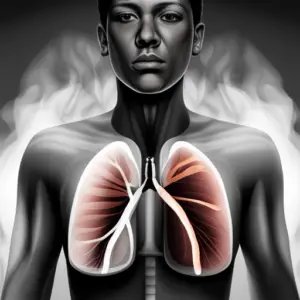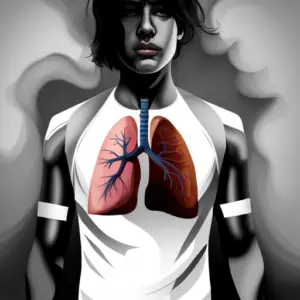Can Occasional Smoking Also Cause High Blood Pressure? Discern potential heart risks of infrequent smoking. Learn quick strategies to quit smoking for a pronounced shift towards well-being.
High blood pressure is a common health condition affecting millions worldwide. Understanding the potential causes and risk factors associated with high blood pressure is essential to prevent its onset and manage it effectively. This article will explore the connection between occasional smoking and high blood pressure. We will also address two main questions: Can occasional smoking contribute to high blood pressure? And how long does it take to quit smoking?
High blood pressure, also known as hypertension, occurs when the force of blood against the walls of the arteries is consistently too high. This condition puts strain on the heart and blood vessels, increasing the risk of heart disease, stroke, and other complications. Understanding what high blood pressure is and how it affects the body is crucial for recognizing the potential impact of smoking on this condition.
Several factors contribute to the development of high blood pressure, including age, family history, obesity, and lack of physical activity. Additionally, smoking has been identified as a significant risk factor for high blood pressure. The chemicals in tobacco smoke can damage blood vessels, reduce oxygen levels in the blood, and increase the heart rate, leading to elevated blood pressure levels.
Both occasional and regular smoking has been linked to an increased risk of high blood pressure. The chemicals in tobacco smoke, such as nicotine, can constrict blood vessels and cause inflammation, making it harder for blood to flow freely. This can result in higher blood pressure readings and contribute to the development of hypertension.
Table of Contents
Understanding the Effects of Occasional Smoking on Blood Pressure

Occasional smoking refers to smoking cigarettes infrequently or sporadically. While occasional smoking may not pose the same health risks as regular smoking, it can still harm the body. Even smoking a few cigarettes intermittently can expose the body to harmful chemicals and increase the risk of various health conditions, including high blood pressure.
Several studies have examined the relationship between occasional smoking and high blood pressure. While the exact mechanism is not yet fully understood, research suggests that occasional smoking can still contribute to increased blood pressure levels. These findings emphasize the importance of reducing or quitting smoking altogether, even if it is done occasionally.
Occasional smoking can lead to increased blood pressure levels by exposing the body to the harmful effects of tobacco smoke. The chemicals present in cigarettes can cause temporary constriction of blood vessels, leading to elevated blood pressure readings. Additionally, the inflammatory response triggered by smoking can further contribute to high blood pressure. It is crucial to recognize that occasional smoking can harm cardiovascular health and should be avoided.
Effects of Occasional Smoking on Blood Pressure:
- Exposure to harmful chemicals: Even occasional smoking exposes the body to harmful chemicals in tobacco smoke, such as nicotine, carbon monoxide, and tar. These chemicals can harm blood vessels, leading to increased blood pressure levels.
- Temporary constriction of blood vessels: Occasional smoking can cause temporary constriction of blood vessels, making it harder for blood to flow freely. This constriction can result in elevated blood pressure readings.
- Inflammatory response: Smoking, even occasionally, triggers an inflammatory response in the body. This inflammation can contribute to developing high blood pressure by further narrowing the blood vessels and increasing the strain on the cardiovascular system.
Importance of Quitting Smoking:
- Long-term health benefits: Quitting smoking, whether occasional or regular, can significantly improve overall health and reduce the risk of various cardiovascular diseases, including high blood pressure.
- Immediate blood pressure reduction: Blood pressure decreases within minutes of quitting smoking. This reduction continues over time, significantly improving blood pressure control.
- Prevention of further damage: Quitting smoking prevents further damage to blood vessels and reduces the risk of complications associated with high blood pressure, such as heart disease and stroke.
How Long Does it Take to Quit Smoking?

The time it takes to quit smoking varies for each individual. While some people may quit successfully after their first attempt, others may require multiple attempts before achieving long-term cessation. Factors that influence the time it takes to quit smoking include the individual’s level of nicotine dependence, support systems in place, and determination to quit.
Nicotine dependence and withdrawal symptoms:
- Nicotine addiction: Nicotine is a highly addictive substance found in tobacco products. The level of nicotine dependence can vary among individuals, making it more challenging for some to quit smoking.
- Withdrawal symptoms: When quitting smoking, individuals may experience withdrawal symptoms such as cravings, irritability, anxiety, and difficulty concentrating. These symptoms can make quitting harder and may last several weeks or longer.
Strategies for quitting smoking:
- Nicotine replacement therapy: Nicotine replacement therapy, including nicotine patches, gums, and inhalers, can help reduce withdrawal symptoms and cravings during the quitting process.
- Behavioral support: Seeking support from healthcare professionals, counselors, or support groups can provide guidance and encouragement during the quitting journey.
- Medications: Prescription medications such as varenicline and bupropion can help reduce nicotine cravings and facilitate smoking cessation.
- Lifestyle changes: Adopting a healthy lifestyle, including regular exercise, stress management techniques, and avoiding triggers, can aid in the quitting process.
Timeframe for quitting smoking:
- Short-term milestones: Within 24 hours of quitting smoking, carbon monoxide levels in the body decrease, allowing more oxygen to reach the heart and muscles. Within 2-3 days, nicotine is eliminated from the body, and the sense of taste and smell improves.
- Long-term milestones: After 1-9 months of quitting, lung function and circulation improve. The risk of heart disease and stroke also decreases. After 1 year, the risk of coronary heart disease is reduced by half compared to a smoker. The longer a person stays smoke-free, the more significant the health benefits become.
Quitting smoking is a personal journey, and the time it takes to quit can vary. It is essential to seek support, develop a personalized quitting plan, and stay committed to long-term cessation to improve overall health and reduce the risk of high blood pressure and other smoking-related diseases.
Can Occasional Smoking Also Cause High Blood Pressure? – FAQs

- Can occasional smoking contribute to high blood pressure?
- Yes, occasional smoking can contribute to high blood pressure. Even smoking a few cigarettes intermittently can expose the body to harmful chemicals present in tobacco smoke, leading to temporary constriction of blood vessels and an inflammatory response that can increase blood pressure levels.
- What are the effects of occasional smoking on blood pressure?
- Occasional smoking exposes the body to harmful chemicals, such as nicotine, carbon monoxide, and tar, increasing blood pressure levels. It can also cause temporary constriction of blood vessels, making it harder for blood to flow freely, and trigger an inflammatory response that further narrows the blood vessels and increases strain on the cardiovascular system.
- How long does it take to quit smoking?
- The time it takes to quit smoking varies for each individual. Factors that influence the time include nicotine dependence, support systems in place, and determination to quit. Some people may quit successfully after their first attempt, while others may require multiple attempts. Withdrawal symptoms, such as cravings, irritability, and difficulty concentrating, may last several weeks or longer.
- What are some strategies for quitting smoking?
- Strategies for quitting smoking include nicotine replacement therapy (patches, gums, inhalers), seeking behavioral support from healthcare professionals or support groups, using medications like varenicline and bupropion, adopting a healthy lifestyle with regular exercise, stress management techniques, and avoiding triggers. These strategies can help reduce withdrawal symptoms and cravings and increase the chances of successful smoking cessation.
Can Occasional Smoking Also Cause High Blood Pressure? – Sources
- American Heart Association: Smoking, High Blood Pressure and Your Health. Available at: https://www.heart.org/en/health-topics/high-blood-pressure/changes-you-can-make-to-manage-high-blood-pressure/smoking-high-blood-pressure-and-your-health. Accessed on July 11, 2023.
- National Center for Biotechnology Information: The Paradox Association between Smoking and Blood. Available at: https://www.ncbi.nlm.nih.gov/pmc/articles/PMC7215755/. Accessed on July 11, 2023.
- Healthline: Does Smoking Increase Your Risk of High Blood Pressure? Available at: https://www.healthline.com/health/high-blood-pressure-hypertension/smoking-and-hypertension. Accessed on July 11, 2023.
- SAGE Journals: Effects of smoking on central blood pressure. Available at: https://journals.sagepub.com/doi/10.1177/1358863X16647509. Accessed on July 11, 2023.
- Centers for Disease Control and Prevention: Prevent High Blood Pressure. Available at: https://www.cdc.gov/bloodpressure/prevent.htm. Accessed on July 11, 2023.
- MedlinePlus: How to Prevent High Blood Pressure. Available at: https://medlineplus.gov/howtopreventhighbloodpressure.html. Accessed on July 11, 2023.
